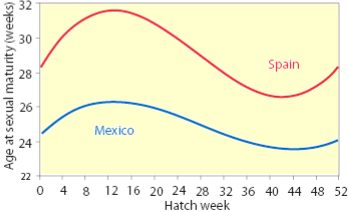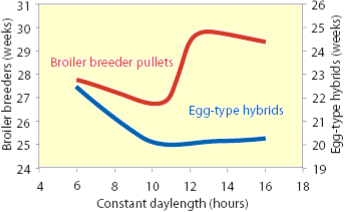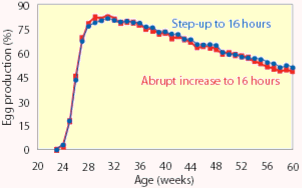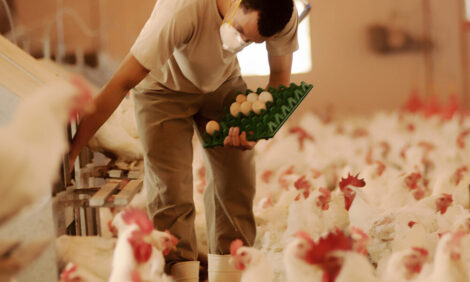



Daylength for broiler breeders – have we got it right?
By Dr Peter Lewis, Consultant. Research suggests that the right lighting pattern for egg-laying hens will not necessarily get the best results from breeders.From the start of the broiler industry in the 1950s, recommendations for lighting breeders have invariably been based on programmes designed for lighting egg-laying hybrids. Typically, these involve an initial period of long days followed by a step-down programme to reach 8 hours by 1-2 weeks of age. The birds are held on 8 hours until about 20 weeks and then transferred to a 10-, 11- or 12-hour day to initiate egg production, followed by a series of weekly increments to reach a maximum of 15 or 16 hours.
The reason for the dependence on egg-type lighting programmes has been the minimal amount of research into the broiler breeder’s response to light, presumably because it was assumed that it would respond similarly to its lower bodyweight, egg-type cousin. However, in recent years fundamental research conducted at the University of KwaZulu-Natal in South Africa has shown that broiler breeders cannot simply be regarded as large chickens and may, in some aspects, be better treated as if they were small turkeys. So what have we got right with broiler breeder lighting, and where do we need to make changes?
Controlled environment in the rearing period
The most important finding of the recent research has been that broiler breeders, unlike egg-type hybrids, still retain a vestige of seasonal breeding. Indeed, surveys of performance in two broiler breeder industries (Mexico and Spain) have shown that despite flocks being grown to typical breeder company bodyweight targets and lit according to their recommendations, they still show a pronounced seasonal variation in the age at which they come into lay (Figure 1). It will be seen that the range is wider in Spain because of the bigger difference between the shortest and longest days at higher latitudes. A characteristic of seasonal breeding birds is that they are unable to respond to a stimulatory daylength when they hatch. Instead, they require a period of short days before they can respond to a transfer to longer days. As a consequence, spring-hatched birds, which have never received less than 12 hours light, are generally the latest flocks to mature. Those that hatch in the autumn will be the earliest to start egg production because they will have experienced the short days of winter during the rearing phase. In nature, this inhibitory mechanism, termed photorefractoriness, stops birds coming into lay in the autumn. This is because food will be scarce, and cold winter conditions will reduce the progeny’s chances of survival.
Figure 1: Effect of hatch date on sexual maturity in broiler breeders kept in the northern hemisphere (subtract or add 26 to produce hatch dates for southern hemisphere flocks).

Turkeys are seasonal breeders and typically need about two months of short days (mimicking winter) at the end of the rearing period to make them responsive to a light increase. However, in contrast to turkeys, broiler breeders are control-fed during rearing. This not only slows up their growth but also delays the dissipation of the refractory condition. As a result, they require more like 5 months of short days before they can be successfully stimulated into egg production with a light increase.
Our research in South Africa has also shown that photostimulating broiler breeders much before 19 weeks – even if feed restriction during rearing is relaxed – is likely to result in a flock of birds being sexually uneven and having a low peak, poor persistency, and variable egg weight. The egg production data in Figure 2 shows the slow entry into egg laying and low peak for birds photostimulated at 15 rather than 20 weeks of age, even though each group was grown to achieve the same bodyweight (2.1kg) by the time of the light change.
Figure 2: Egg production for 2.1kg body weight broiler breeders given an increase in daylength at 15 or 20 weeks.

There is little difference in the age at which egg production begins when birds are reared on 6, 8 or 10-hour days and transferred to 16-hour days at 20 weeks. So it seems that there is little wrong with the current recommendation to rear broiler breeders on 8-hour days prior to a transfer to long days at about 20 weeks of age (Table 1).
| Performance Of Broiler Breeders On 6, 8, or 10 Hour Daylengths And Transferred To Sixteen Hours At Twenty Weeks | |||
| Daylengths During Rearing (Hours) | Age At 50% Egg Production (Days) | No Of Eggs To 60 Weeks Of Age | Average Egg Weight (g) |
|---|---|---|---|
| 6 | 196 | 161 | 68.1 |
| 8 | 193 | 169 | 67.5 |
| 10 | 196 | 171 | 68.4 |
Non-lightproof or open-sided housing in the rearing period
Contrastingly, the advice to rear spring-hatched birds that are kept in open-sided or non-lightproof housing on a daylength equal to the longest anticipated natural daylength is incorrect, even though this continues to be an appropriate lighting policy for rearing commercial egg layers. Broiler breeders that are never exposed to short days take much longer to become responsive to an increase in daylength. Indeed, those reared on long days take about 3 weeks longer to start egg production than birds reared on 8-hour days and never photostimulated. This is completely opposite to the response of egg-laying birds (Figure 3). A further problem when broiler breeders are given long days during the rearing period is that it leaves little opportunity to photostimulate them when they are moved into the laying house.
Figure 3: Age at 50% egg production in broiler breeder and egg-type hybrids kept on constant daylenghts

In one of the trials in South Africa, we compared three different lighting programmes during the rearing period:
- a naturally increasing daylength from either 10 or 11 hours to 14 hours
- a decreasing schedule from 14 hours down to 10 hours, or
- a constant 14-hour daylength.
There was only 3 days difference between the various treatments in the time taken to reach 50% egg production after they had all been transferred to a 16-hour day at 20 weeks. This demonstrates the dominant role that the feeding programme plays in the control of sexual maturity in broiler breeders. However, the failure to provide the 14-hour birds with any short days meant that this group had very poor persistency; some birds will have gone out of lay, and overall, they laid 6-10 fewer eggs to 60 weeks than the groups reared on the simulated natural lighting programmes (Table 2). For seasonal breeding species that are held on long days, the greater the delay in the start of egg production means they go out of lay sooner at the end of the breeding season.
| Performance Of Broiler Breeeders Reared On Simulated Naturally Increasing Or Decreasing Daylengths Of Constant 14 Hour Days Before A Transfer Of 16 Hour Days At 20 Weeks | |||
| Lighting Programme To 20 Weeks | Age At 50% Egg Production (Days) | No. Of Eggs To 60 Weeks Of Age | Average Egg Weight (g) |
|---|---|---|---|
| Increasing From 10-14 Hours | 209 | 150 | 170.0 |
| Increasing From 11 To 14 Hours | 210 | 146 | 69.8 |
| Decreasing From 14 To 10 Hours | 209 | 150 | 69.4 |
| Constant 14 Hours | 212 | 141 | 68.9 |
Controlled environment in the laying period
Egg production over the laying cycle when broiler breeders are given a single increase from 8 to 16 hours at 20 weeks of age is inferior to that when they are transferred to only 12-hour days. Data in Figure 4 from a trial conducted in South Africa show that birds transferred to 16 hours came into lay slightly earlier than 12-hour birds, but had poorer egg production after peak, which resulted in the production of 10 fewer eggs to 60 weeks of age.
Figure 4: Egg production for broiler breeders abruptly transferred from 8 to 12 hours or from 8 to 16 hours at 20 weeks.

Other birds were transferred to 12 hours at 19 weeks then given four further increases to reach 16 hours at 23 weeks. Their egg numbers to 60 weeks were similar to those for birds changed to 16 hours in a single increase at 19 weeks. However, there were differences in the pattern of egg production, as occurs in egg-type hybrids: birds that were abruptly increased came into lay slightly earlier and had a higher peak rate of lay than birds that had been given the gradual increase. However, the latter group had better egg production at the end of the laying period (Figure 5).
Figure 5: Egg production for broiler breeders given a single increase from 8 to 16 hours at 19 weeks or an initial increase to 12 hours then a series of further increases to reach 16 hours at 23 weeks.

These findings suggest that broiler breeders do not need to be given 15 or 16-hour daylengths (as recommended by most breeding companies); a single transfer to 12 hours will be adequate for maximum egg production. Laying hens require 1% more energy per hour when they are in light than when they are in darkness. When broiler breeders are given a fixed daily amount of feed and 12 hours of light, they will have 4% more energy available for egg production than birds given 16 hours light.
Non-lightproof or open-sided in the laying period
It is probably sensible to give broiler breeders a 16-hour day in the laying period when they are kept in non-lightproof accommodation. This gives more opportunity to photostimulate (albeit minimally) birds when they are transferred to the laying house in mid summer, and avoids a decrease in daylength after the longest day.
Lighting of males
Research has yet to be concluded on the response of males to lighting. Preliminary results suggest that males respond to a lighting programme in a similar way to females. That is, they also require a 4-5 month period of short days during rearing and should not be photostimulated much before 20 weeks of age if uniform sexual maturation is to be achieved.
What’s wrong…what’s right?
- The recommendation to rear broiler breeders that are kept in controlled environment housing on 8-hour days and transfer them to 11 or 12 hours is sound.
- The breeders’ advice to photostimulate at 20-21 weeks is absolutely correct. This ensures that, within a flock that has been grown to reach 2.0-2.2kg by 20 weeks, all birds will be able to respond to an increase in daylength.
- When birds are reared in non-lightproof (open-sided) accommodation, it is probably better to expose them to naturally changing daylengths than to rear them on a constant long day.
- It is unnecessary to continue increasing the daylength to 15 or 16 hours in a lightproof laying house; 12 hours is perfectly adequate for maximising egg production.
- 16-hour daylengths need to be given to birds kept in open-sided or non-lightproof housing at high latitudes, but this can be reduced to 14 or 15 hours to match the longest natural daylength at lower latitudes.
To order a copy of 'Poultry Lighting the theory and practice' please click here.
October 2007
A version of this article was first published in the May 2006 edition of Poultry International Magazine












